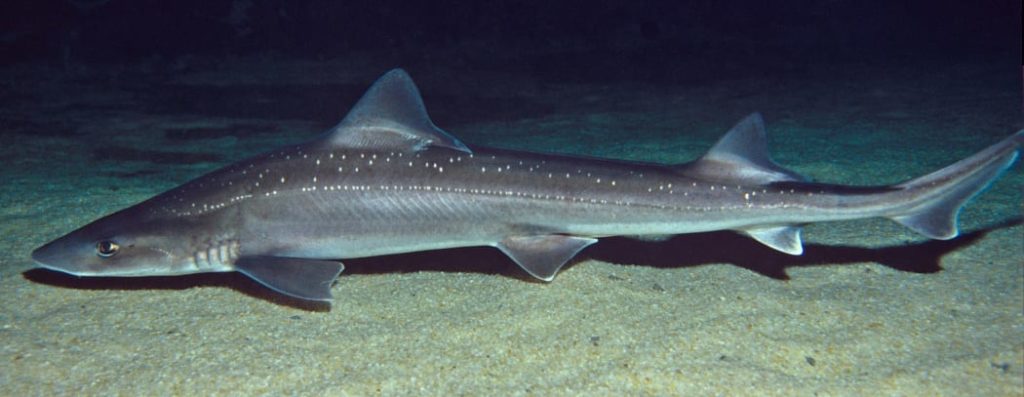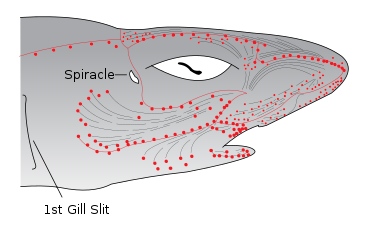Rig Shark
The rig shark (Mustelus lenticulatus), an intriguing marine creature also known as the spotted smooth-hound, is a unique and remarkable species of small shark that you can find in the Pāuatahanui Inlet. It is also sometimes called the ‘spotted dogfish’ but this is a false identifier because true dogfish are a different family of shark.
The rig is a shallow water shark only found in New Zealand where it is very common throughout coastal waters, particularly in shallow bays and estuaries. Generally bronze in colour on the upper surface with numerous blue and white spots, the underside is plain white. The body shape is characterised by having two dorsal fins and an anal fin.

Rig are fascinating to observe due to their amazing physical characteristics and behaviors. The rig feeds mainly on animals that burrow in the sea floor, especially Crustacea such as crabs. The main diet is the stalk-eyed mud crab (Macrophthalmus hirtipes), constituting up to 95% of the total taken, with hairy-handed crab (Hemigrapsus crenulatus) making up most of the rest. The teeth are flattened and arranged like paving stones to form grinding plates designed for crushing. This gives it the nick-name of gummy shark. Feeding is accomplished by sucking up mouthfuls of sea floor sediment containing the burrowed animals. The shark separates out the prey by ejecting the mud and sand through its gills, leaving the animals behind to be crushed and swallowed.
This feeding habit also enables a rig to maintain respiration without the need to keep moving. Unlike many other sharks, the rig can maintain a flow of water over its gills while remaining relatively still in the shallow waters of the estuaries.
Scientific Classification
- Kingdom: Animalia
- Phylum: Chordata
- Class: Chondrichthyes
- Order: Carcharhiniformes
- Family: Triakidae
- Genus: Mustelus
- Species: M. lenticularus

Rig, like all sharks, can sense the presence of prey using the sensitive ampullae of Lorenzini, located around the snout. These are a collection of tubules that open to the sea by small pores and are electrically sensitive to the muscular activity of the small Crustacea helping the rig to locate a buried population of invertebrates with little difficulty.
These predators are known to spend their days hovering at the bottom of the sea, preferring depths of about 20-80 meters. At night, however, they become more active and may feed on a diet composed of small fish and invertebrates.
During the much of the year most adult rig spend their lives in open waters but during spring and summer mature females, 4-7yrs old, make inshore migrations, congregating in sheltered, shallow, harbours and estuaries to breed. Breeding is accomplished by internal fertilisation through mating, meaning eggs and sperm are not shed into the water like many fish.
Unlike many shark, rig are viviparous; that is they give birth to live young with the eggs maturing within the body of the female over a period of 11 months after fertilisation. The young are born at a size of 20 to 30cm, with each female producing an average of 11 offspring. This occurs during the months of October to December with the new-born fish staying in the Inlet, possibly through to April or June. The young grow rapidly, reaching maturity in 5-8 years, with a natural lifespan of over 15.
After mating, adults remain in the harbour during the remainder of the summer months and it is known that several males can mate with one female, i.e. they are polygamous. By the end of February most adults have returned to the open sea. During the next spring males tend to return to the same estuary and, therefore, are local to the Inlet, while females can come from a wider area of the coast.
The rig sharks are capable of growing up to a meter in length and have a slim, streamlined body which makes them an excellent underwater predator. Their stunning dark brown or black spots set against a lighter background make them stand out and easy to distinguish from other marine creatures.
Despite their harmless nature and no threat to humans, fishermen frequently catch rig sharks due to their high oil content and delicious meat. As part of New Zealand’s coastal ecology, rig shark is a highly important inshore commercial fish species, less prone to overfishing than most shark. You will probably know it as ‘lemon fish’ and, under this name, have eaten it as the ubiquitous serving of ‘fish and chips’.
‘Rig are taken mainly by set net and bottom trawl (banned within the Inlet) and there are six managed stocks of rig around New Zealand shores with three within 40km of Porirua harbour.

This makes Pāuatahanui Inlet a highly important breeding ground for rig and undoubtedly, these sharks play a vital role in the ecosystem.